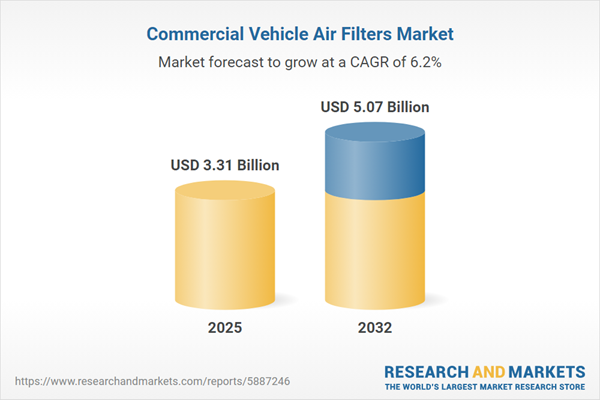Speak directly to the analyst to clarify any post sales queries you may have.
The commercial vehicle air filter market is navigating a pivotal phase as evolving powertrain technologies, stricter emissions standards, and new customer priorities redefine product specifications and supply strategies for fleets and manufacturers.
Market Snapshot: Commercial Vehicle Air Filters Market Overview
The Commercial Vehicle Air Filters Market grew from USD 3.12 billion in 2024 to USD 3.31 billion in 2025. It is expected to continue growing at a CAGR of 6.24%, reaching USD 5.07 billion by 2032. Increasing regulatory demands, a shift toward electrification, and the need for durable, high-efficiency filtration solutions are driving stakeholder focus in this sector. Leading OEMs and aftermarket suppliers are responding with innovative filter designs, enhanced performance monitoring, and sustainability-focused product offerings to address the requirements of modern commercial fleets.
Scope & Segmentation
- Product Offerings:
- Cabin Air Filter
- Activated Carbon Filter
- Charcoal Cabin Air Filter
- Electrostatic Cabin Air Filter
- Particulate Cabin Air Filter
- Engine Air Filter
- Foam Engine Air Filters
- Gauze Engine Air Filters
- Paper Engine Air Filters
- Filter Types:
- Dry Air Filter
- Oiled Air Filter
- Filter Shapes:
- Cone
- Panel
- Vehicle Types:
- Heavy Commercial Vehicles
- Buses
- Heavy-Duty Trucks
- Light Commercial Vehicles
- Compact Trucks
- Utility Vehicles
- End-Uses:
- Aftermarket
- Original Equipment Manufacturer
- Regional Coverage:
- Americas: United States, Canada, Mexico, Brazil, Argentina, Chile, Colombia, Peru
- Europe, Middle East & Africa: United Kingdom, Germany, France, Russia, Italy, Spain, Netherlands, Sweden, Poland, Switzerland, United Arab Emirates, Saudi Arabia, Qatar, Turkey, Israel, South Africa, Nigeria, Egypt, Kenya
- Asia-Pacific: China, India, Japan, Australia, South Korea, Indonesia, Thailand, Malaysia, Singapore, Taiwan
- Leading Companies:
- Ahlstrom, Alco Filters Ltd., Ashley Filters, CabinAir Sweden AB, Cummins Inc., Denso Corporation, Donaldson Company, Inc., Freudenberg Filtration Technologies GmbH & Co. KG, General Motors Company, Hanon Systems, Hengst SE, Hollingsworth & Vose Company, K&N Engineering, Inc., Lydall, Inc., Mahle GmbH, MANN+HUMMEL International GmbH & Co. KG, Nirvana India Pvt Ltd, Parker Hannifin Corporation, Robert Bosch GmbH, Sogefi S.p.A., Spectrum Filtration Pvt. Ltd., Toyota Boshoku Corporation, UFI FILTERS S.p.A., UNO Minda Limited, Valeo S.A.
Key Takeaways for Commercial Vehicle Air Filters Market
- Advanced filter media such as electrostatic fibers and activated carbon are being introduced to enhance particulate capture without increasing flow resistance.
- Embedded sensors and telematics integration are gaining traction, enabling real-time maintenance and predictive replacement cycles for maximum fleet uptime.
- Sustainability is a core concern, with market players moving toward biodegradable materials and recycled components to reduce environmental impact.
- Electrification and hybrid powertrains are driving new types of filtration challenges, particularly relating to HVAC and battery cooling systems.
- OEM–supplier collaborations and digital servicing models are creating new competitive frontiers and recurring revenue opportunities in both developed and emerging markets.
Tariff Impact on Air Filter Supply Chains
The 2025 implementation of new United States tariff policies is set to alter the landscape for manufacturers reliant on imported filter media or components. These measures increase pressure on margins and expedite the search for alternative sourcing, domestic production, or redesigned products. Product classifications for tariff purposes have triggered engineering changes and redefined distribution strategies. Early moves toward nearshoring and long-term supply contracts are strengthening supply continuity and buffer against volatility.
Methodology & Data Sources
This research combines extensive secondary analysis of regulations, patents, and financial disclosures with structured interviews from OEMs, distributors, and material suppliers. Triangulation with technical lab data and field feedback ensures practical and credible insights for the commercial vehicle air filters market.
Why This Report Matters
- Enables executive teams to align R&D and procurement strategies with emerging regulatory and sustainability trends for commercial vehicle air filtration.
- Equips stakeholders to navigate the impact of policy changes, supply chain disruptions, and technology adoption in critical regional markets.
- Provides actionable recommendations to capture opportunities and mitigate risks across the value chain.
Conclusion
As commercial vehicle designs evolve and regulatory frameworks intensify, stakeholders must leverage insights on innovation, supply chain shifts, and customer demands. This report offers essential strategic direction to drive resilience and secure long-term value in the commercial vehicle air filters market.
Additional Product Information:
- Purchase of this report includes 1 year online access with quarterly updates.
- This report can be updated on request. Please contact our Customer Experience team using the Ask a Question widget on our website.
Table of Contents
3. Executive Summary
4. Market Overview
7. Cumulative Impact of Artificial Intelligence 2025
Companies Mentioned
The companies profiled in this Commercial Vehicle Air Filters market report include:- Ahlstrom
- Alco Filters Ltd.
- Ashley Filters
- CabinAir Sweden AB
- Cummins Inc.
- Denso Corporation
- Donaldson Company, Inc.
- Freudenberg Filtration Technologies GmbH & Co. KG
- General Motors Company
- Hanon Systems
- Hengst SE
- Hollingsworth & Vose Company
- K&N Engineering, Inc.
- Lydall, Inc.
- Mahle GmbH
- MANN+HUMMEL International GmbH & Co. KG
- Nirvana India Pvt Ltd
- Parker Hannifin Corporation
- Robert Bosch GmbH
- Sogefi S.p.A.
- Spectrum Filtration Pvt. Ltd.
- Toyota Boshoku Corporation
- UFI FILTERS S.p.A.
- UNO Minda Limited
- Valeo S.A.
Table Information
| Report Attribute | Details |
|---|---|
| No. of Pages | 182 |
| Published | November 2025 |
| Forecast Period | 2025 - 2032 |
| Estimated Market Value ( USD | $ 3.31 Billion |
| Forecasted Market Value ( USD | $ 5.07 Billion |
| Compound Annual Growth Rate | 6.2% |
| Regions Covered | Global |
| No. of Companies Mentioned | 26 |









